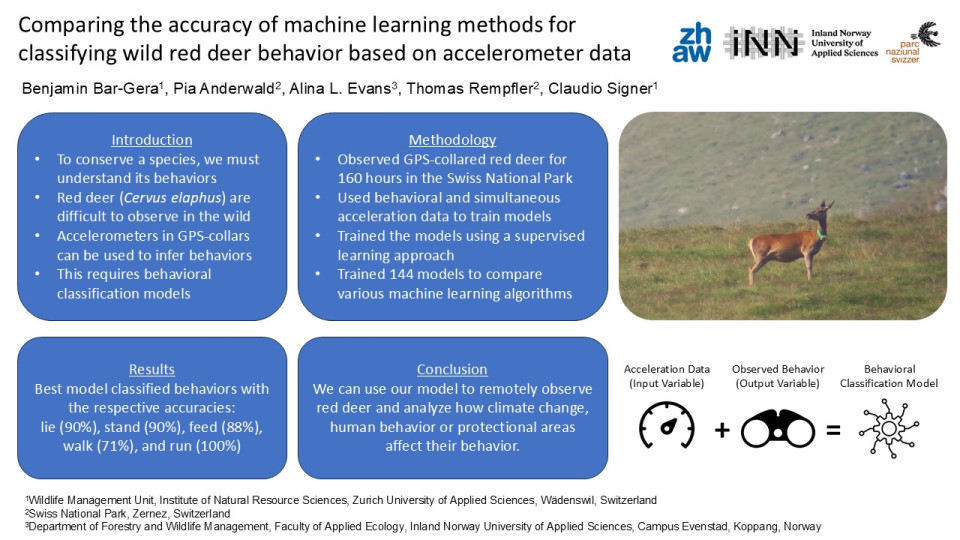To effectively conserve a species, it is necessary to understand its behaviors. However, some species can be difficult to observe in the wild, as they are nocturnal, shy or travel over large distances. One such species is the red deer (Cervus elaphus). To overcome these challenges, researchers frequently use GPS collars fitted with accelerometers to better understand the behaviors of wild red deer and other ungulates. While the GPS data provides information regarding spatial behaviors, the accelerometers can be used to infer knowledge regarding the animals’ physical activity. Furthermore, combined with classification models, data collected by accelerometers on a collar can be used to determine an animal’s actual behaviors, and therefore allow us to “observe” these animals without visually seeing them. This data can be used as a basis for conservation practices or to answer questions such as how climate change or human activity might impact the behavior of these animals.
Previous ungulate classification studies have mostly trained their models using data from GPS-collared captive animals. While this is more efficient and convenient than using data from GPS-collared wild animals, data from captive animals may not be representative of the behaviors displayed by wild individuals. To fill this gap, we decided to train our models with wild red deer. As such, we spent 60 days in the Swiss National Park, observing GPS-collared red deer and recording their behavior. In a second step, we used a supervised learning approach with the data collected from the wild red deer to train the behavioral classification models. While the accelerometer data collected on multiple axes served as an input variable, the simultaneously observed behavior was used as the output variable. Further, we used a variety of machine learning algorithms, as well as combinations and transformations of the accelerometer data to identify those that generated the most accurate classification models. To determine which models performed most accurately, we derived a new metric which considered the imbalance between different behaviors.
We found significant differences in the models’ performances depending on which algorithm and combination of input variables was used. In essence, discriminant analysis generated the most accurate classification models when combined with multiple input variables and was able to accurately differentiate between the behaviors lying, feeding, standing, walking, and running. In contrasts to using data from captive animals, collecting enough observational data from wild red deer required a significant amount of field work and physical effort. However, our results were comparable to models trained on captive ungulates, with the distinguishing knowledge that our models are well-suited to classify the behaviors of wild red deer living in an Alpine environment. We plan to use these classification models as a basis for future studies to analyze what effects the hunting regime has on the behavior of wild red deer. We also hope that our comparison of the various machine learning algorithms and transformation methods can be used in future behavioral classification projects when deciding which algorithms and methods to use. Finally, we hope that the metric we used to compare the various models may shed some insight on the benefits and limitations of such acceleration-based behavioral classification models.
Quiz question
Basierend auf welche Daten, konnten wir das Verhalten der Rothirsche klassifizieren?
Körpertemperatur
Beschleunigungsdaten
GPS-Positionen
